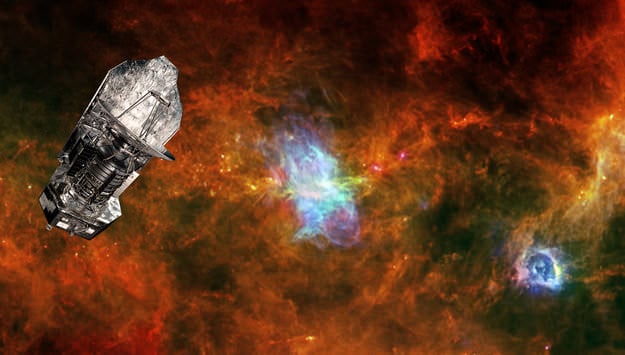Sadly – though as expected – the most powerful far-infrared orbital telescope put in orbit has ended mission. The Herschel space observatory has now run out of liquid helium coolant, ending more than three years of pioneering observations of the cool Universe.
The spacecraft needs to be at temperatures as low as 0.3 Kelvin, or minus 459 degrees Fahrenheit to make its observations, and mission scientists and engineers knew since Herschel's launch on May 14, 2009 that the 2,300 liters of liquid helium would slowly evaporate away.
The Herschel team sent out a notice that the helium was finally exhausted today, noted at the beginning of the spacecraft's daily communication session with its ground station in Western Australia. The data showed a clear rise in temperatures measured in all of Herschel's instruments.
"Herschel has exceeded all expectations, providing us with an incredible treasure trove of data that that will keep astronomers busy for many years to come," said Alvaro Giménez Cañete, ESA's Director of Science and Robotic Exploration.
The Herschel telescope will be parked indefinitely in a heliocentric orbit, as a way of "disposing" of the spacecraft. It should be stable for 100s of years, but perhaps scientists will figure out another use for it in the future.
One original idea for disposing
of the spacecraft was to have it impact the Moon,
a la
the LCROSS mission that slammed into the Moon in 2009, and it would kick up volatiles at one of the lunar poles for observation by another spacecraft, such as the Lunar Reconnaissance Orbiter. But that idea has been nixed in favor of parking Herschel in a heliocentric orbit.
What has Herschel done in its three years of observations? It has made over 35,000 scientific observations, amassing more than 25,000 hours' worth of science data from about 600 different observing programs. A further 2,000 hours of calibration observations also contribute to the rich dataset, which is based at ESA's European Space Astronomy Centre, near Madrid in Spain.
But there will be more news the future from Herschel's observations, as scientists comb through the data. The Herschel team said today that the telescope's data is expected to provide even more discoveries than have been made during the lifetime of the Herschel mission.
"Herschel's ground-breaking scientific haul is in no little part down to the excellent work done by European industry, institutions and academia in developing, building and operating the observatory and its instruments," saids Thomas Passvogel, ESA's Herschel Program Manager.
"Herschel has offered us a new view of the hitherto hidden Universe, pointing us to a previously unseen process of star birth and galaxy formation, and allowing us to trace water through the Universe from molecular clouds to newborn stars and their planet-forming discs and belts of comets," said Göran Pilbratt, ESA's Herschel Project Scientist.
Source:
ESA
 Universe Today
Universe Today
